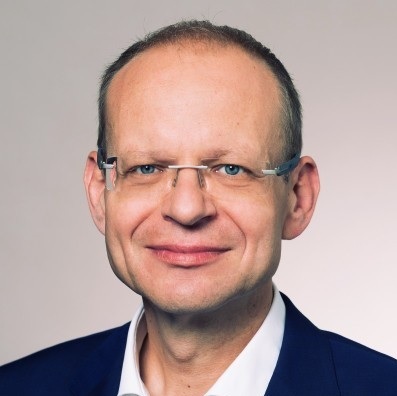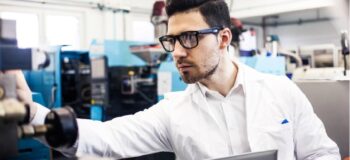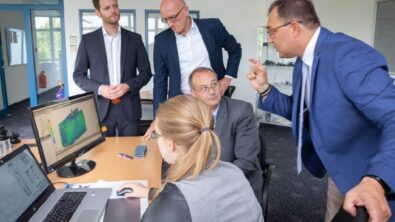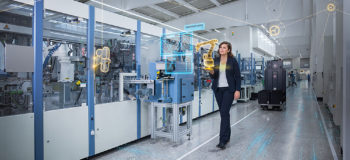The future of smart machines and smart industries – Transcript ep. 1

Our engineering experts, Dale Tutt, VP of Industry Strategy; Rahul Garg, VP of Industrial Machinery; and Michael Thomas, SVP of Factory Automation and Head of Production Machines, discuss the trends and challenges in the manufacturing ecosystem today, including technological advances on the horizon, and the role of digitalization in enabling the future of smart manufacturing.
Read the transcript below or listen to the audio podcast.
Conor: OK, welcome everyone.
We’re here to talk today about smart machines and how they enable smart factories. I would like to start with just a brief introduction from our guests today. So, Michael, if you could please start us off and just give us a brief history of your career and your experience with smart machines and smart factories and so forth.

Michael: Sure. My name is Michael Thomas and I’m in charge of automation of machinery within Siemens. This is what we call production machines, so any kind of printed goods, bottled water, whatever comes out of machinery, we are automating. I have been with Siemens for 30 years, starting my career in R&D and the last 20 to 25 years in the domain of automation and machinery.
Conor: Excellent. Thank you very much. Rahul, would you like to go next?

Rahul: Sure. My name is Rahul Garg and I’m responsible for the industrial machinery vertical inside the Siemens software business. I’ve been looking after this for the last 15 years, and prior to that I was part of the industries and marketing organization. Prior to this, I started my career as a software developer, deploying large systems, PLM and PDM systems at large enterprise companies.
Conor: Excellent. Dale, finally.

Dale: Hey, Connor. I’m Dale Tutt. I lead the global industry strategy team for Siemens Digital Industries Software. In my role, my team is responsible to develop industry solutions for our customers and lead the go-to market efforts for how we do and how we talk to our customers and where we see business opportunities. So that’s the focus.
Before I joined Siemens, I was in the aerospace and defense industry for about 30 years, designing and building airplanes and spaceships. I lead a lot of engineering programs and some manufacturing programs, being able to leverage some of that experience. I joined Siemens as the aerospace and defense industry lead several years ago and now, I have all the industry strategies.

Conor: Awesome. Well, thank you guys all for joining me today to talk about smart machines and smart factories. I’m really looking forward to this conversation and to kick it off, Michael, I’m going to come back to you. You know, I guess to start us off today, I’m curious, what do you see are the challenges that are facing the manufacturing ecosystem today, and what trends do you see in the business landscape, and finally, how is that creating hurdles for the producers of goods and companies that support them?
Michael: When I started in R&D 13 years ago there was always the situation that we had an idea, but at the end, some technology was missing, and we had to wait until that technology was developed by us. When you look at machine builders today, it’s totally the other way around. Machine builders are challenged every day by getting new technologies on their table, to consider whether this technology will make any difference to the market? It is essential to investigate machine building, manufacturing on efficiency, cost, time to market, or the aspects of individualization of products and quality.
What is newly coming on the horizon is that we as consumers in our buying behavior of products, put a lot of weight on sustainability. Also, whenever I talk to machine builders, it’s obvious that there’s a huge lack of talents in most of the countries which are building machines and the end customers for operation in manufacturing. And that all leads to a very challenging situation that, on the one hand, as technologies are fast changing. Emerging new markets are coming up in terms of immobility, and in sustainability. Just investigate the plastics industry and their substitutions on materials. On the other hand, the number of people which can deal with these challenges are also becoming more limited.
Conor: So, Dale, Rahul, and Michael, you all mentioned things like a shortage of skilled labor and supply shortages. How are these trends manifesting for factories and machine builders as well? How do you see that changing in the next five years for these companies?
Dale: As Michael talked about the sustainability challenges and the workforce challenges, it is really a big one for many of our customers, as these large manufacturers (OEMs) and some of their suppliers produce a couple of challenges:
- They must produce products faster. They’re trying to improve their yield, less scrap, less waste in their production lines.
- They need to be more flexible so that they can be more responsive to the changing demands of their customers.
These are some of the bigger challenges they have. And I think one of the other things that we’re starting to see is when relying on manual labor, there is a shortage of technicians when turning to more automation to help overcome labor shortages. But it’s not merely automation in their production line, like with robotics, it’s also the process that they use to get the information out to the people in the shop floor. There’s a lot more automation that they’re looking at, along with their production processes.
Rahul: Yes, those are great points. I think what Michael and Dale covered is relevant to sustainability related issues in trying to reduce the amount of energy a machine consumes to also introduce more automation and robotics into the production processes, especially in developed countries with a lot of the thoughts around reshoring occurring. And it’s also driving the need to improve operational efficiencies and automation.
The other big angle is that as the workforce challenges continue, there is a critical need to simplify the systems that are used by the shop floor personnel. And as part of introducing the technologies, how do you make it easier for someone to get online and up and running quickly with a modern look and feel as part of the whole process and a modern user interface, which is a very critical function to try and drive greater adoption with the workforce as well
Dale: A common thread that we’re seeing among these various industries that we work with, and the trends that we’ve been talking about between Michael, Rahul, and myself, is immense growth and complexity in the way these companies operate today that’s changing the way they do business and how they’re going to develop the next generation of products. And then to manufacture those products, and see how it’s affecting a multitude of processes across all of production. So, Michael, how do you see this complexity affecting the way factories are managed today?
Michael: What I see is that we are moving from automated production facilities to more adaptive and flexible production facilities with many elements of automated optimization of the entire manufacturing plant that’s also influencing machines. There are three major pillars: electrification, automation, and digitalization. Combining all three enables machine builders to simplify highly complex technical stuff by looking at the PLM process, the design, the virtual commissioning of a machine, and evaluating machine performance before building a prototype on the line level and factory.
People are seeking this because the complexity, in combination with highly demanding end-customer markets and a volatile market environment, creates a lot of uncertainty about whether this is the right time to invest. All this evaluation helps to lower the risk and to become more predictable in the planning process, design process, and operation of the facilities.
Dale: Michael, I like how you characterized that these large companies or large manufacturers are dealing with the increasing challenges of complexity. I like that they’re turning towards electrification, automation, and digitalization to help them have more sustainable and repeatable processes as they move forward. So, thinking about that from the big level, Rahul, how about the machine builders? When we look at the factory, and the machines inside that factory, they are a major element. Therefore, how is complexity affecting the way the industrial machinery is being designed?
Rahul: Yes, to deliver on some of these expectations of smart manufacturing or adaptive manufacturing, as Michael indicated, the machine builders who are providing that equipment must transform the way they are doing their design, engineering, building, manufacturing processes and support processes.
They are moving from what was traditionally a sequential process to a more integrated mechatronic-based process where all the multidiscipline engineering activities happen together. The mechanical, electrical, automation, and design processes work tenuously, creating a digital twin of the entire machine, leveraging more simulation as part of the whole process, enabling the buyer of the machine that the factory and user are given, can also evaluate the entire performance of that machine and manner. Therefore, before they go through a commissioning phase, they can evaluate how the machine will work in the context of the entire line and make any adjustments in a virtual world before cutting a single piece of metal and going through the whole commissioning process.
So, this helps ensure what they’re going to deliver is going to meet the customer’s needs, number one. And #2, most importantly, get it to the customer site in the fastest time possible without having any downtime or any on site operational issues. Then, more importantly, from an ongoing operational perspective, having the ability to monitor what’s going on and make any adaptive changes in the way the equipment is running.
So, if you see any issues, you can proactively predict the problems that could happen and resolve those before they become a bigger problem. These are some of the things that the machine builders are trying to incorporate into their operational processes to see how they can leverage new technologies and new capabilities to transform internal operations.
Michael: In addition, many machine builders come from well-established domains, but markets are changing, and the printing industry is merely one example of this. If they are forced to move into new domains, what is the value of the domain, what are the potential new areas to enter when you are in that situation where you must transform a business company, like a mid-sized machine builder, into new areas? The best thing you can do is make sure that you minimize the risk on the one hand and be as fast as possible to adapt to new areas to educate your people and take them off this.
On this journey of transformation, and what I observed in the market, companies that can adapt to new technologies, utilizing the portfolio and the available technology. These are the ones that are also primarily successful in this kind of transformation process, and it started in the printing industry.
When I look at the industry segments today, more are already in progress of this kind of transformation, or at the beginning of the transformation. One example we can refer to is the printing industry with totally new technologies, as we talk about a packaging print instead of merely printed media.
Also, we talk about functional and 3D printing, taking it from 3/3 printing of pieces to 3D printing of housing properties, which is in the industry domain, not having any great productivity by technology in the last 100 years. We see a lot of adjacent new markets, and they are only possible to explore if you combine all the various technologies with automation at the core, connecting to IT while utilizing AI technology.
Learn more in the podcast.
Siemens Digital Industries Software helps organizations of all sizes digitally transform using software, hardware and services from the Siemens Xcelerator business platform. Siemens’ software and the comprehensive digital twin enable companies to optimize their design, engineering and manufacturing processes to turn today’s ideas into the sustainable products of the future. From chips to entire systems, from product to process, across all industries. Siemens Digital Industries Software – Accelerating transformation.


